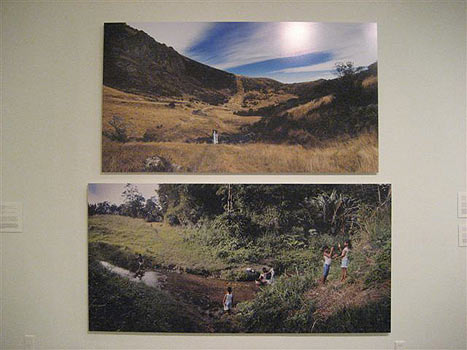El Museo del Barrio,
Jul 25, 2007 - Jan 06, 2008
New York, NY, USA
El Museo's Bienal: The (S) Files 2007
by Aldo Sánchez
During the past few years Sandra Valenzuela (Mexico City, 1980) has photographed objects such as Q tips, tampons and condoms, lit in such a way as to give them a clinical look; she has also done interesting exercises on still lifes. She subsequently devoted a complete series entitled Media-noche to the still-life genre. This time she was inspired by the paintings of the Spanish Baroque artist Sánchez Cotán, specifically as regards vegetables hanging on strings, part of which are on display at The (S) Files. Under a blue background, Valenzuela photographs vegetables covered with little coats/socks she knitted herself. According to her description,(4) the title is a play on the words media (stocking) and noche (night: medianoche means midnight).(5) Neither the photograph nor the title is interesting: although the image is turned around to give the impression that the vegetables are gravitating, the knitted wear does not contribute to the visual theme other than decoratively.
Valenzuela is currently working on a series entitled X, the development of which is interesting to see: it plays with sexual identity and with the capacity for transformation that self-portraits can provide.
Perhaps to fill a gay quota in the exhibition,(6) the biennial includes three videos by Ivan Monforte (Mérida, Yucatán, 1973), in which as part of a performance the artist appears looking straight at the camera, expressionless and wearing the same clothes. Each video is titled in keeping with the song he uses as background music (I belong to you, Que te vaya bonito y There but for the grace of God go I). The variations are that Monforte sometimes appears alone, sometimes embracing the lover referred to in the song, or crying before the camera; in one video the background includes disco lights. The result is pretty flawed, the movements are stiff, and he does not manage to pull off an effective performative action before the camera, nor to spark an emotional response in the viewer through the performance: the feelings stem from the songs. Any song is bound to be moving when sung by Chavela Vargas.
Also focusing on performance and a capacity for resistance, Jessica Lagunas (Managua, 1971) applies lipstick before the camera repeatedly, to the point of exaggeration in order to achieve the opposite of what make-up is supposed to do. The same applies to the video Para acariciarte mejor [The Better to Caress You], in which she applies coat after coat of nail varnish to achieve a grotesque effect. The statement these videos seek to make is not just out of date, but obvious. The beauty rituals to which women are subjected by social convention have been repeatedly explored since the sixties, so the subject calls for a more complex approach.
Andrés García Peña (Milan, 1961) makes an interesting contribution to the exhibition with his painting Plaza de la venganza no 2 [Vengeance Plaza No. 2], in which humanized but ghostly bulls smoke and drink in a bullring while a bull gores the bullfighter. The painting would look perfect in a bar but fortunately forms part of The (S) Files. The interpretation and combination of influences make for an interesting composition, a blend of Leonora Carrington, Chagall and art naïf that is compelling due to its perspective, colors, characters and subject matter.
One must inevitably question the yardstick and the reason for being of The (S) Files.(7) To begin with, the open-invitation approach through which artists are selected is uninteresting in curatorial terms; if that approach is chosen, then a term other than biennial would be more appropriate. Making it a requisite to be Latin American or of Latin American origin makes the exhibition reductionist and ghettoizing. If the idea is to put on an exhibition with artists from Latin America, the mission should be clearer than merely drawing up a long list (more than 50 artists in the exhibition!); it would be more to the point to define the ultimate purpose of the exhibition, or to reflect on current trends as colored by a Latin American context; in short, something more specific than a hodge-podge of unconnected, scattered works. What makes Latin American artists so special as to warrant a Latin American exhibition? If the idea is to explore that theme, it would be more beneficial for viewers and artists alike to do so using a critical approach with more specific aims in mind.
Aldo Sánchez (b. México) lives in New York. He is the Program Coordinator at the Instituto Cultural de México in Nueva York and holds a Master in Curatorial Practice from the California College of the Arts.
Quotes:
(1) In a conversation with María del Carmen Carrión, curator of New Langton Arts, San Francisco, California.
(2) Rodolfo Kronfle, "Ecuador: La vida en estado puro" in 007 El Museo's 5th Biennial catalogue, p 25. El Museo del Barrio, 2007.
(3) Ramos, E. Carmen "Arte americano sin fronteras: La Bienal The (S) Files 2007" in 007 El Museo's 5th Bienal, p. 22.
(4) Valenzuela, Sandra. 007 El Museo's 5th Bienal, p. 118.
(5) It is also supposedly a reference to the Cuban medianoche the name of a typical sandwich in Cuba - which is even less interesting to the interpretation of the image*. Op. cit. p. 118.
(6) The other two artists who deal with gay topics are Reinaldo Sanguino (Caracas, 1973) y Alex Morel (New York, 1973).
(7) The exhibition catalogue is bilingual and although it is well printed the translations are so poor that some of the texts are incomprehensible.
|











